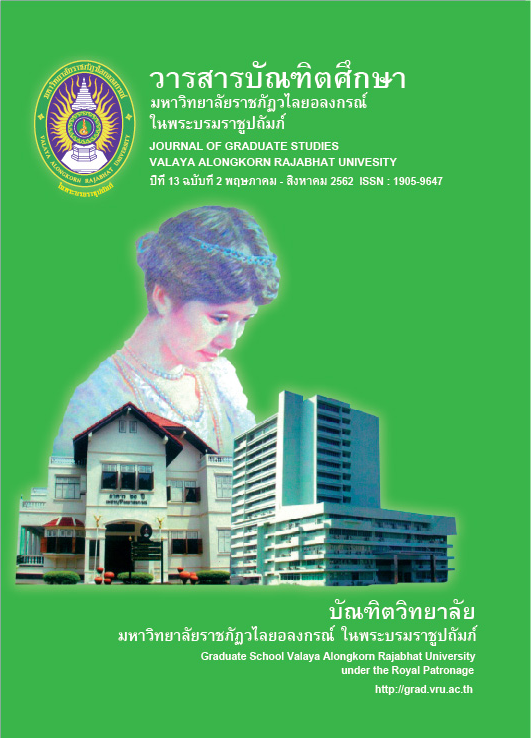CREATING A PRODUCT INDENTITY TO ENHANCE THE COMMUNITY OF PHET SAMUT KHIRI ECONOMIC COMMUNITY PROJECT '' BAN PHET PLEN DIN''
Main Article Content
Abstract
This research aims to 1) study and review local identities of Phet Samut Khiri in the context of the area, 2) the development of the theoretical concept 4 DNA and the formation of the group of Phet Samut Khirian, and 3) limitations and obstacles to development of the identity of Phet Samut Khiri. This research is quality research. The researcher use methodology by PAR: Participatory Action Research. By analyzing the performance of the main group of key informant.The researcher identified 3 majors informant groups based on time frame of research. Phase 1: YEC: (Young Entrepreneur Chamber of Commerce) 12 people and representatives of 16 community members in provinces. And Phase 2: representatives from 400 localities from 4 provinces.
The research found that 1) local resources can be developed as identities of each province by evaluating the cultural dimension, there are total employment 2) the evolution of the symbolic elements of Phet Samut Khiri province. It is the result of the consensus of key informants who represent the people in the four provinces together with their facilitators and designers. Then brought all the details to develop with the software program on the computer with the color scheme. The design of each part of the image. The darker color, more beautiful. The symbol of Phet Samut Khiri province, it can be used to balance the economy of each province 3) problems found in the area as follows: 3.1 Phetchabui province, some communities and attractions have not been coordinated by government to refine the landscape and add amenities that still do not cover all areas and people in Phetchaburi are traditional and lack knowledge in product and service. 3.2 Samut Songkhram province, some travel and learning centers may not be suitable for the elderly. The lack of facilities is available in each area and traditional urban planning is still a problem for the traffic of the visitors. 3.3 Samut Sakhon province, arts and crafts as souvenirs, some souvenirs exported. It cannot be produced to meet the needs of the market in large quantities and the lack of dissemination of local knowledge and wisdom. 3.4 Prachuap Khiri Khan province, length of space distribution and economic prosperity do not cover all districts. The transportation system requires a long period of travel between the districtor major attractions within the province. Length of space, the distribution and economic prosperity are not covered at all. The district also has a long term transportation system. Traveling between districts or major attractions within the province. The rise of entertainment and gray business continues to spread and coping with traffic jams on the road during long holidays.
Article Details

This work is licensed under a Creative Commons Attribution-NonCommercial-NoDerivatives 4.0 International License.
บทความทุกเรื่องได้รับการตรวจความถูกต้องทางวิชาการโดยผู้ทรงคุณวุฒิ ทรรศนะและข้อคิดเห็นในบทความ Journal of Global of Perspectives in Humanities and Social Sciences (J-GPHSS) มิใช่เป็นทรรศนะและความคิดของผู้จัดทำจึงมิใช่ความรับผิดชอบของบัณฑิตวิทยาลัย มหาวิทยาลัยราชภัฏวไลยอลงกรณ์ ในพระบรมราชูปถัมภ์ กองบรรณาธิการไม่สงวนสิทธิ์การคัดลอก แต่ให้อ้างอิงแหล่งที่มา
References
Dhanasana, T., Chuntuk, T., & Siriwong, P. (2009). [The Development Indicator to Create Relativity for New GenerationEnhance for Operation Plan Reducing Conflict in Business at Diversity Cultural Organization]. Veridian E-Journal, Silpakorn University, 9(2), 2172-2189.
Hirankitti, P., et al. (2014). phrưttikam kānthō̜ngthīeo chœ̄ng kasēt khō̜ng nakthō̜ngthīeo chāo Thai [Agro-Tourism Behavior of Thai Tourists]. Suthiparithat. 28 (88) 363-384.
Kemmis, S., & McTaggart, R. (1988). The Action Research Reader. Geelong, Australia: Deakin University Press.
Ministry of Tourism and Sports. (2018). rāingān wičhai that kānthō̜ngthīeo Thai pī sō̜ngphanhārō̜ihāsipkāo [Thai Tourism Research Report 2559]. Bangkok: Ministry of Tourism and Sports.
Pinkaew, P., khiaomaeng, K., & Wongsingthong, P. (2017). kānsưksā ʻēkkalak phāplak bukkhalikkaphāp čhangwat Nakhō̜n Pathom [A Study of the Identity, Image and Personality of Nakhon Pathom Province]. Journal of Silpakorn University Language Thai. 37(1), 223-244.
Treetrong, E, Pangkesorn, A., Tubtimcharoon, N., & Keonil, N. (2014). sētthakit sāngsan: kān sanœ̄ nænǣo thāngkān ʻō̜k bǣp saphāpwǣtlō̜m phāinai rōngrǣm khanāt lek nai tāng čhangwat phư̄a songsœ̄m sakkayaphāp kānthō̜ngthīeo Thai [Creative Economy: Suggestions for the Design of Environment in Small Hotels in Upcountry to Promote Thai Tourism Potential]. Research Report Silpakorn University Research and Development.
Wattana, C. (2012). kānsưksā phư̄a kamnot ʻattalak thanon watthanatham( thanon khon dœ̄n ) khō̜ng čhangwat phitsanulōk [A Study to Determine the Identity of the Phitsanulok Cultural Street (Walking Street)]. Journal of Business, Economics and Communications. 7(2), 271-280.
Xuto, N. (2008). kānwičhai chœ̄ng khunnaphāp [Qualitative research]. (4th) Bangkok: Printpro.


